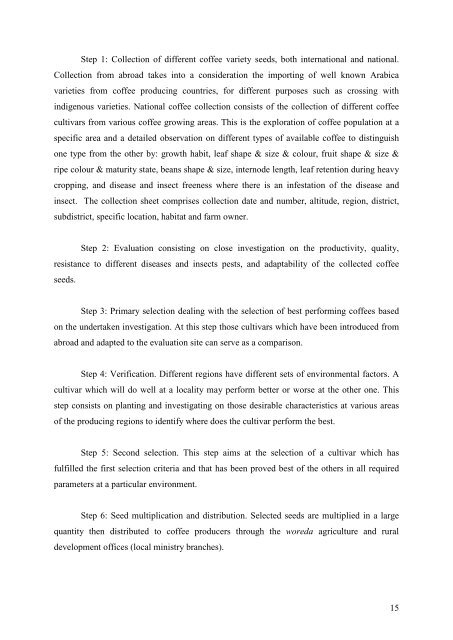A study case on coffee (Coffea arabica): Limu Coffe - IRD
A study case on coffee (Coffea arabica): Limu Coffe - IRD
A study case on coffee (Coffea arabica): Limu Coffe - IRD
Create successful ePaper yourself
Turn your PDF publications into a flip-book with our unique Google optimized e-Paper software.
Step 1: Collecti<strong>on</strong> of different <strong>coffee</strong> variety seeds, both internati<strong>on</strong>al and nati<strong>on</strong>al.<br />
Collecti<strong>on</strong> from abroad takes into a c<strong>on</strong>siderati<strong>on</strong> the importing of well known Arabica<br />
varieties from <strong>coffee</strong> producing countries, for different purposes such as crossing with<br />
indigenous varieties. Nati<strong>on</strong>al <strong>coffee</strong> collecti<strong>on</strong> c<strong>on</strong>sists of the collecti<strong>on</strong> of different <strong>coffee</strong><br />
cultivars from various <strong>coffee</strong> growing areas. This is the explorati<strong>on</strong> of <strong>coffee</strong> populati<strong>on</strong> at a<br />
specific area and a detailed observati<strong>on</strong> <strong>on</strong> different types of available <strong>coffee</strong> to distinguish<br />
<strong>on</strong>e type from the other by: growth habit, leaf shape & size & colour, fruit shape & size &<br />
ripe colour & maturity state, beans shape & size, internode length, leaf retenti<strong>on</strong> during heavy<br />
cropping, and disease and insect freeness where there is an infestati<strong>on</strong> of the disease and<br />
insect. The collecti<strong>on</strong> sheet comprises collecti<strong>on</strong> date and number, altitude, regi<strong>on</strong>, district,<br />
subdistrict, specific locati<strong>on</strong>, habitat and farm owner.<br />
Step 2: Evaluati<strong>on</strong> c<strong>on</strong>sisting <strong>on</strong> close investigati<strong>on</strong> <strong>on</strong> the productivity, quality,<br />
resistance to different diseases and insects pests, and adaptability of the collected <strong>coffee</strong><br />
seeds.<br />
Step 3: Primary selecti<strong>on</strong> dealing with the selecti<strong>on</strong> of best performing <strong>coffee</strong>s based<br />
<strong>on</strong> the undertaken investigati<strong>on</strong>. At this step those cultivars which have been introduced from<br />
abroad and adapted to the evaluati<strong>on</strong> site can serve as a comparis<strong>on</strong>.<br />
Step 4: Verificati<strong>on</strong>. Different regi<strong>on</strong>s have different sets of envir<strong>on</strong>mental factors. A<br />
cultivar which will do well at a locality may perform better or worse at the other <strong>on</strong>e. This<br />
step c<strong>on</strong>sists <strong>on</strong> planting and investigating <strong>on</strong> those desirable characteristics at various areas<br />
of the producing regi<strong>on</strong>s to identify where does the cultivar perform the best.<br />
Step 5: Sec<strong>on</strong>d selecti<strong>on</strong>. This step aims at the selecti<strong>on</strong> of a cultivar which has<br />
fulfilled the first selecti<strong>on</strong> criteria and that has been proved best of the others in all required<br />
parameters at a particular envir<strong>on</strong>ment.<br />
Step 6: Seed multiplicati<strong>on</strong> and distributi<strong>on</strong>. Selected seeds are multiplied in a large<br />
quantity then distributed to <strong>coffee</strong> producers through the woreda agriculture and rural<br />
development offices (local ministry branches).<br />
15

















